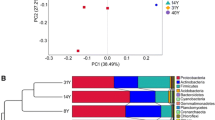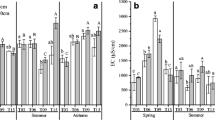Abstract
Purpose
Changes in microbial communities during natural succession in semiarid areas have been widely studied but their association with plant and soil properties remains elusive. In the present study, we investigated plant characteristics, rhizosphere soil variables, and microbial communities along a chronosequence of grasslands forming on abandoned farmland on the Chinese Loess Plateau.
Materials and methods
Rhizosphere samples were collected from the early-stage dominant plant Artemisia capillaris from farmland abandoned for 5, 10, and 15 years and from the late-stage dominant plant Artemisia sacrorum from farmland abandoned for 10, 15, 20, and 30 years. Microbial community composition, including bacteria and fungi, was determined by high-throughput sequencing. Microbial succession rates represented by temporary turnover were assessed using the slope (w value) of linear regressions, based on log-transformed microbial community similarity over time.
Results and discussion
Cover and aboveground biomass of A. capillaris tended to decrease, whereas those of A. sacrorum increased during the succession. Although the rhizosphere bacteria of A. capillaris transitioned from Proteobacteria-dominant to Actinobacteria-dominant, the bacteria of A. sacrorum exhibited the opposite trend. Bacterial and fungal community diversity tended to increase logarithmically with increasing plant aboveground biomass, indicating that an increase in plant biomass could lead to enhanced rhizosphere microbial diversity, but the rate of enhancement decreased gradually. A lower temporary turnover rate of bacterial and fungal communities in the rhizosphere than that in the bulk soil indicated a higher successional rate of the rhizosphere microbial community. Levels of soil nutrients, such as organic carbon, nitrate nitrogen, and ammonium nitrogen, were closely associated with the abundance and diversity of bacterial and fungal communities, indicating their critical role in shaping the rhizosphere microbial community.
Conclusions
Our results indicate a close association between plant succession and rhizosphere microbial succession in a semiarid area. Plants affect the microbial communities possibly by changing the nutrient input into the rhizosphere.







Similar content being viewed by others
References
Becquer A, Trap J, Irshad U, Ali MA, Claude P (2014) From soil to plant, the journey of P through trophic relationships and ectomycorrhizal association. Front Plant Sci 5:548
Bell CW, Asao S, Calderon F, Wolk B, Wallenstein MD (2015) Plant nitrogen uptake drives rhizosphere bacterial community assembly during plant growth. Soil Biol Biochem 85:170–182
Blaalid R, Carlsen T, Kumar S, Halvorsen R, Ugland KI, Fontana G, Kauserud H (2012) Changes in the root-associated fungal communities along a primary succession gradient analysed by 454 pyrosequencing. Mol Ecol 21:1897–1908
Bremner JM, Mulvaney CS (1982) Nitrogen-total. In: Page AL, Miller RH, Keeney DR (eds) Methods of soil analysis. Part 2. Chemical and microbial properties. Agronomy Society of America Agronomy Monograph 9, Madison, pp 595–624
Chagas FO, Pessotti RC, Caraballo-Rodriguez AM, Pupo MT (2018) Chemical signaling involved in plant-microbe interactions. Chem Soc Rev 47:1652–1704
Cline LC, Zak DR (2015) Soil microbial communities are shaped by plant-driven changes in resource availability during secondary succession. Ecolgy 96(12):3374–3385
Davey M, Blaalid R, Vik U, Carlsen T, Kauserud H, Eidesen PB (2015) Primary succession of Bistorta vivipara (L.) Delabre (Polygonaceae) root-associated fungi mirrors plant succession in two glacial chronosequences. Environ Microbiol 17(8):2777–2790
Deng L, Shangguan ZP, Sweeney S (2014) “Grain for Green” driven land use change and carbon sequestration on the Loess Plateau, China. Sci Rep 4:7039
Development Core Team R (2013) R version 3.0.1: a language and environment for statistical computing. R Foundation for Statistical Computing, Vienna
Fierer N, Bradford MA, Jackson RB (2007) Toward an ecological classification of soil bacteria. Ecology 88:1354–1364
Fierer N, Nemergut DR, Knight R, Craine JM (2010) Changes through time: integrating microorganisms into the study of succession. Res Microbiol 161:635–642
Filep T, Draskovits E, Szabo J, Koos S, Laszlo P, Szalai Z (2015) The dissolved organic matter as a potential soil quality indicator in arable soils of Hungary. Environ Assess 187(7):479
Foster BL, Tilman D (2000) Dynamic and static views of succession: testing the descriptive power of the chronosequence approach. Plant Ecol 146:1–10
Franke-Whittle IH, Manici LM, Insam H, Stres B (2015) Rhizosphere bacteria and fungi associated with plant growth in soils of three replanted apple orchards. Plant Soil 395:317–333
Freedman ZB, Upchurch RA, Zak DR, Cline LC (2016) Anthropogenic N deposition slows decay by favoring bacterial metabolism: insights from metagenomic analyses. Frontier Microbiol 7:259
Goldfarb KC, Karaoz U, Hanson CA, Santee CA, Bradford MA, Treseder KK, Wallenstein MD, Brodie EL (2011) Differential growth responses of soil bacterial taxa to carbon substrates of varying chemical recalcitrance. Frontier Microbiol 2:94
Harantová L, Mudrák O, Kohout P, Elhottová D, Frouz J, Baldrian P (2017) Development of microbial community during primary succession in areas degraded by mining activities. Land Degrad Dev 28:2574–2584
He F, Yang BS, Wang H, Yan QL, Cao YN, He XH (2016) Changes in composition and diversity of fungal communities along Quercus mongolica forests developments in Northeast China. Appl Soil Ecol 100:162–171
Horner-Devine MC, Lage M, Hughes JB, Bohannan BJM (2004) A taxa-area relationship for bacteria. Nature 432:750–753
Jach-Smith LC, Jackson RD (2018) N addition undermines N supplied by arbuscular mycorrhizal fungi to native perennial grasses. Soil Biol Biochem 116:148–157
Jones DL, Nguyen C, Finlay RD (2009) Carbon flow in the rhizosphere: carbon trading at the soil-root interface. Plant Soil 321:5–33
Kardol P, De Deyn GB, Laliberte E, Mariotte P, Hawkes CV (2013) Biotic plant-soil feedbacks across temporal scales. J Ecol 101(2):309–315
Klironomos JN (2003) Variation in plant response to native and exotic arbuscular mycorrhizal fungi. Ecology 84:2292–2301
Knelman JE, Grahama EB, Trahand NA, Schmidt SK, Nemerguta DR (2015) Fire severity shapes plant colonization effects on bacterial community structure, microbial biomass, and soil enzyme activity in secondary succession of a burned forest. Soil Biol Biochem 90:161–168
Kulmatiski A, Beard KH, Stevens JR, Cobbold SM (2008) Plant-soil feedbacks: a meta-analytical review. Ecol Lett 11:980–992
Kuramae EE, Gamper HA, Yergeau E, Piceno YM, Brodie EL, DeSantis TZ, Andersen GL, Van veen JA, Kowalchuk GA (2010) Microbial secondary succession in a chronosequence of chalk grasslands. ISME J 4:711–715
Lagos LM, Navarrete OU, Maruyama F, Crowley DE, Cid FP, Mora ML, Jorquera MA (2014) Bacterial community structures in rhizosphere microsites of ryegrass (Lolium perenne var. Nui) as revealed by pyrosequencing. Biol Fertil Soils 50:1253–1266
Lambers H, Mougel C, Jaillard B, Hinsinger P (2009) Plant-microbe-soil interactions in the rhizosphere: an evolutionary perspective. Plant Soil 321:83–115
Lankau EW, Lankau RA (2014) Plant species capacity to drive soil fungal communities contributes to differential impacts of plant–soil legacies. Ecology 95(11):3221–3228
Liang Y, Jiang Y, Wang F, Wen C, Deng Y, Xue K, Qin Y, Yang Y, Wu L, Zhou J, Sun B (2015) Long-term soil transplant simulating climate change with latitude significantly alters microbial temporal turnover. ISME J 9(12):2561–2572
Lima AB, Cannavan FS, Navarrete AA, Teixeira WG, Kuramae EE, Tsai SM (2015) Amazonian dark earth and plant species from the Amazon region contribute to shape rhizosphere bacterial communities. Microbial Ecol 69:855–866
Lozano YM, Hortal S, Armas C, Pugnaire FI (2014) Interactions among soil, plants, and microorganisms drive secondary succession in a dry environment. Soil Biol Biochem 78:298–306
Marschner P, Yang CH, Lieberei R, Crowley DE (2001) Soil and plant specific effects on bacterial community composition in the rhizosphere. Soil Biol Biochem 33:1437–1445
McHugh TA, Morrissey EM, Mueller RC, Gallegos-Graves LV, Kuske CR, Reed SC (2017) Bacterial, fungal, and plant communities exhibit no biomass or compositional response to two years of simulated nitrogen deposition in a semiarid grassland. Environ Microbiol 19(4):1600–1611
Millard P, Singh BK (2010) Does grassland vegetation drive soil microbial diversity? Nutr Cycl Agroecosyst 88(2):147–158
Mukherjee S, Heinonen M, Dequvire M, Sipilä T, Pulkkinen P, Yrjälä K (2013) Secondary succession of bacterial communities and co-occurrence of phylotypes in oil-polluted Populus rhizosphere. Soil Biol Biochem 58:188–197
Munoz-Rojas M, Erickson T, Martini D, Dixon KW, Merritt DJ (2016) Soil physicochemical and microbiological indicators of short, medium nd long term post-fire recovery in semi-arid ecosystems. Ecol Indic 63:14–22
Nelson DW, Sommers LE (1982) Total carbon, organic carbon, and organic matter. In: Page AL, Miller RH, Keeney DR (eds) Methods of soil analysis. Part 2. Chemical and microbial properties. Agronomy Society of America, Agronomy Monograph 9, Madison, pp 539–552
Olsen SR, Sommers LE (1982) Phosphorous. In: Page AL, Miller RH, Keeney DR (eds) Methods of soil analysis. Part 2. Chemical and microbial properties. Agronomy Society of America, Agronomy Monograph 9, Madison, Wisconsin, pp 403–430
Paredes HS, Lebeis SL (2016) Giving back to the community: microbial mechanisms of plant–soil interactions. Funct Ecol 30:1043–1052
Peay KG, Kennedy PG, Bruns TD (2011) Rethinking ectomycorrhizal succession: are root density and hyphal exploration types drivers of spatial. Fungal Ecol 4:233–240
Poosakkannu A, Nissinen R, Mannisto M, Kytoviita MM (2017) Microbial community composition but not diversity changes along succession in arctic sand dunes. Environ Microbiol 19:698–709
Siciliano SD, Palmer AS, Winsley T, Lamb E, Bissett A, Brown MV, van Dorst J, Ji M, Ferrari BC, Grogan P, Chu HY, Snape I (2014) Soil fertility is associated with fungal and bacterial richness, whereas pH is associated with community composition in polar soil microbial communities. Soil Biol Biochem 78:10–20
Spohn M, Treichel NS, Cormann M, Schloter M, Fischer D (2015) Distribution of phosphatase activity and various bacterial phyla in the rhizosphere of Hordeum vulgare L. depending on P availability. Soil Biol Biochem 89:44–51
Tscherko D, Ute H, Marie-Claude M, Ellen K (2004) Shifts in rhizosphere microbial communities and enzyme activity of Poa alpina across an alpine chronosequence. Soil Biol Biochem 36:1685–1698
Walker LR, Walker J, Hobbs RJ (2007) Linking restoration and ecological succession. Springer, Amsterdam, pp 5–21
Wang GL, Liu GB, Xu MX (2009) Above and belowground dynamics of plant community succession following abandonment of farmland on the Loess Plateau, China. Plant Soil 316:227–239
Welc ME, Frossard E, Egli S, Else K, Bünema JJ (2014) Rhizosphere fungal assemblages and soil enzymatic activities in a 110-years alpine chronosequence. Soil Biol Biochem 74:21–30
Xiong J, Peng F, Sun H, Xue X, Chu H (2014) Divergent responses of soil fungi functional groups to short-term warming. Microb Ecol 68:708–715
Zeng QC, An SS, Liu Y (2017) Soil bacterial community response to vegetation succession after fencing in the grassland of China. Sci Total Environ 609:2–10
Zhang C, Liu GB, Xue S, Wang GL (2015) Changes in rhizospheric microbial community structure and function during the natural recovery of abandoned cropland on the Loess Plateau China. Ecol Eng 75:161–171
Zhang C, Liu GB, Xue S, Wang GL (2016) Soil bacterial community dynamics reflect changes in plant community and soil properties during the secondary succession of abandoned farmland in the Loess Plateau. Soil Boil Biochem 97:40–49
Zhang C, Liu GB, Song ZL, Qu D, Fang LC, Deng L (2017) Natural succession on abandoned cropland effectively decreases the soil erodibility and improves the fungal diversity. Ecol Appl 27(7):2142–2154
Zhang KR, Cheng XL, Shu X, Liu Y, Zhang QF (2018) Linking soil bacterial and fungal communities to vegetation succession following agricultural abandonment. Plant Soil 431:19–36
Zhou WJ, Sha LQ, Schaefer DA, Zhang YP, Song QH, Tan ZH, Deng Y, Deng XB, Guan HL (2015) Direct effects of litter decomposition on soil dissolved organic carbon and nitrogen in a tropical rainforest. Soil Biol Biochem 81:255–258
Zhou J, Jiang X, Zhou BK, Zhao BS, Ma MC, Guan DW, Li J, Chen SF, Cao FM, Shen DL, Qin J (2016) Thirty four years of nitrogen fertilization decreases fungal diversity and alters fungal community composition in black soil in northeast China. Soil Biol Biochem 95:135–143
Funding
National Natural Sciences Foundation of China (41701556, 41771554), National Key Research and Development Program of China (2016YFC0501707), and Chinese University Scientific Fund (2452017111).
Author information
Authors and Affiliations
Corresponding author
Additional information
Responsible editor: Jizheng He
Publisher’s note
Springer Nature remains neutral with regard to jurisdictional claims in published maps and institutional affiliations.
Electronic supplementary material
ESM 1
(DOC 1768 kb)
Rights and permissions
About this article
Cite this article
Song, Z., Liu, G. & Zhang, C. Response of rhizosphere microbial communities to plant succession along a grassland chronosequence in a semiarid area. J Soils Sediments 19, 2496–2508 (2019). https://doi.org/10.1007/s11368-019-02241-6
Received:
Accepted:
Published:
Issue Date:
DOI: https://doi.org/10.1007/s11368-019-02241-6




